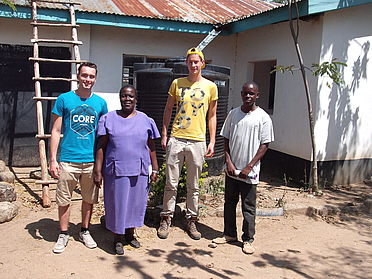Rainwater harvesting at the Okana primary school
Jorrit Horst en Joey Volwater, Kenya
In December 2013 we did a research project at the Okana Primary School for three and a half weeks. Our main objective was to check the feasibility of collecting rainwater using the roof of the school for the purpose of drinking water. We looked at the quantity of the rainfall and the quality of the collected rain. By looking at quantity we could make a design for the gutters and the volume of the tank. The quality aspect is important to see if the collected rainwater is actually drinkable. Because we were only in Kenya for three and a half weeks we only focused on the research. With the research we were able comment on the feasibility and make a design for the building which we hope could be implemented one day.
To collect data and information we have spoken with several local people from the Okana town. As example, the head teacher of the Okana Primary School told us that the children prefer drinking water from the current rainwater harvesting tanks. So, with a quality test on the Electrical conductivity (EC) of the well water we discovered that the EC value of this water was very high. Because of a lack of maintenance and construction the current rainwater harvesting tanks do not effectively collect water. Also the turbidity of the water is very high during the first millimetres of a rain event. Therefore the tanks need a first flush system to avoid the inflow of contaminated water. Test on the contamination for the presence of E.coli bacteria in the different drinking water supplies were not very positive. We tested the collected water samples in the Huisman water lab at the Moi University.
In terms of quantity, a lot of local people told us about a dry period and a wet period during the year. However, looking at the rainfall data from the weather station at the airport of Kisumu near Okana, there is not a clear dry or wet period. The rainfall is almost evenly distributed, there is in some months less precipitation and in some months more, but in every month there is enough rainfall. All needed data and information for our research is in collaboration with local people collected and the local people were concerning with the project. With the information we were able to estimate the required sizes of the storage tanks and the gutters for collecting the rain water. By visiting the largest local hardware stores we could identify what kind of gutters and tanks are actually available in the area. This way we could get an estimate of the total investment needed to build the system. In future we hope that our research will get a continuation and the rainwater harvesting installation would be build at the Okana Primary School. The organisation of Students for sustainability is willing to do this.
